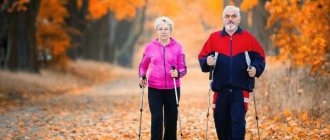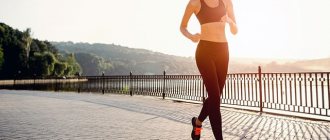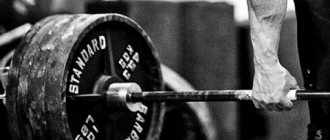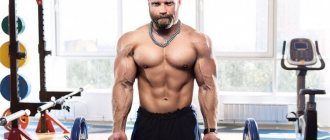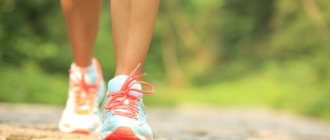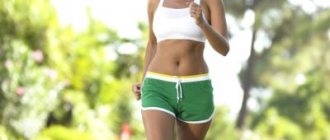Surprise, questions, perplexed glances towards people walking briskly in parks with poles similar to skiing are long gone. Residents of Russia appreciated the benefits of a simple but very effective sport - Nordic walking. Nordic, Nordic or Finnish walking - as it is also called - is indeed officially recognized as a sport and is not inferior to swimming in terms of physical activity. Therefore, this type of activity is suitable for strengthening muscles in old age.
Nordic walking with poles for the elderly indications
Most people associate old age with the appearance of many ailments, so none of us strive for the title of “elderly” person.
The topic of physical exercise in old age becomes, on the one hand, relevant, and on the other hand, dangerous. Unlike ordinary sports, Nordic walking has a health level that has virtually no restrictions on age and health.
Nordic walking for older people is recommended in the following cases:
- If you suffer from diseases of the cardiovascular system, it is prescribed as a means of rehabilitation after a heart attack, stroke, or after heart surgery.
- You experience hand tremors and develop Parkinson's disease.
- Problems with joints and spine, cervical spine (osteochondrosis, scoliosis, rheumatism, arthrosis).
- For diabetes mellitus (not the most severe stage).
- If you are worried about persistent bronchitis or have bronchial asthma.
- If you have problems with blood supply to the lower extremities (varicose veins).
For what diseases is Nordic walking beneficial?
Like any sports technique, Nordic walking has its indications and contraindications (we wrote about this in great detail here). Exercise is especially beneficial for people suffering from certain chronic diseases:
- Mild or moderate hypertension;
- Atherosclerosis;
- Bronchial asthma or chronic bronchitis;
- Diabetes mellitus without severe complications;
- Obesity;
- Osteoporosis;
- Arthrosis, osteochondrosis;
- Chronic cerebral ischemia;
- Coronary heart disease (mild angina, consequences of myocardial infarction);
- Parkinsonism.
Nordic walking is also relevant for older people who do not have serious health problems. In this case, it has a general strengthening effect on the body, increases immune defense, normalizes sleep, tones the nervous system, heart and blood vessels.
Benefits for the elderly
The advantages and benefits of Nordic walking for older people are multifaceted:
- Availability, simplicity, and low cost (no specific skills or equipment are required) make it attractive to all ages, including the elderly.
- During Nordic walking training, up to 90% of all muscle groups are involved in the process, as in swimming.
- Has a beneficial effect on cerebral circulation.
- The endurance of the cardiovascular system is strengthened; Nordic walking is a cardio workout that helps reduce heart rate at rest.
- The neuropsychological state improves - sleep normalizes, depression disappears, stress is relieved.
- Leg muscles and joints are unloaded through the use of sticks.
- Due to the fact that both hemispheres are simultaneously and evenly involved in the work (due to the work of the hands), balance and coordination of movement develop.
- The social factor - communication with like-minded people, the emergence of new acquaintances is important for an elderly person who may be at home most of the time.
- Fresh air greatly increases the benefits of training and brings joy.
How quickly does the positive effect appear?
To achieve a visible effect, regular, systematic exercises are required in compliance with all the rules. The first changes are usually noticeable after 4-5 workouts, but a lasting improvement in health occurs only after a year of full-fledged training. Some diseases (arthrosis, asthma, bronchitis) are corrected within several months, others require longer-term movement therapy (osteoporosis, diabetes, atherosclerosis).
Nordic walking is one of the most effective ways to maintain physical activity in older people. It can be combined with other workouts approved by your doctor. Another advantage of Nordic walking is the expansion of your social circle when practicing in a group of like-minded people.
What special equipment is required?
To practice Nordic walking, you need comfortable clothes and sneakers, as well as sticks. Clothes should be comfortable and not restrict your movements; it is best to wear a tracksuit.
Sneakers should have fairly thick soles, comfortable lacing, and not heavy. It is best to choose running shoes for rough terrain.
The benefits of walking
Walking helps maintain health and good physical shape into old age. Regular walks:
- reduce cholesterol levels, strengthen the walls of blood vessels;
- increase muscle tone;
- improve the functioning of the respiratory system;
- normalize digestion processes, relieve constipation;
- improve brain function due to greater blood flow;
- increase joint mobility;
- improve mood;
- increase life expectancy.
Walking reduces the risk of diabetes, pancreatitis, and stomach ulcers. Slow walks will prevent the development of atherosclerosis, gout, and osteochondrosis. Walking in combination with a properly selected diet will quickly get rid of excess weight.
Step-by-step instructions for choosing the right poles for older people
The initial step when choosing poles is to determine the required length. The comfortable length of the poles was determined experimentally. EXEL was a pioneer in the production of Nordic walking poles; they asked the founder of modern Nordic walking, Marco Kantanev, to select the optimal length, and as a result of his research, they derived a formula for selecting the required length. The formula is as follows, coefficient * human height in cm, the coefficient can be from 0.6 to 0.70. For older people, it is best to take the lower limit of this coefficient, i.e. the stick should be lower. So, for an elderly person with a height of -165 cm, the length of the instrument should be 100-105 cm.
Beginners may mistakenly believe that they can get by with regular ski poles, but this is not the case. They are much longer and their tips will quickly wear off as they move along the asphalt.
When choosing, you should pay attention to the following details:
- The barrel can be extendable, it can be folded and the length can be adjusted, but its disadvantage will be its low strength compared to a solid barrel. The material of the main part of the stick should be lightweight so that you hardly feel them when walking.
- It is better to take a removable tip, because it wears out quickly, in which case you could easily replace it. In addition, you should have rubber “boots” for the tips, which you will wear when walking on asphalt, concrete and other hard surfaces.
- The handle and glove should be made of hypoallergenic materials, not cause irritation, and hold the hand well.
- Special leg weights are recommended for use only by trained people.
How to choose poles?
A properly structured training program is important, but without quality equipment it is impossible to get the benefits. Equipment manufacturers offer telescopic poles and fixed-length models. For people of advanced age, it is more advisable to purchase one-piece models with a fixed structure. As a rule, older Nordic walking enthusiasts practice in close proximity to their place of residence, their height will not change, and the purpose of the training is purely health-improving. Therefore, there is no need to purchase telescopic equipment, the advantage of which is its compact folded size and the ability to change the length of the poles in order to train in different intensity modes. In addition, monolithic poles are safer, because they are devoid of mechanisms that require more attention during operation of the equipment.
Sticks differ not only in design, but also in materials of manufacture. There are affordable models made of aluminum and composite alloys on sale, which can be of quite high quality. But the best choice would be poles containing carbon fiber, which makes the equipment light and durable. The optimal price-quality ratio is inherent in models whose shafts contain at least 20–30% carbon fiber.
Telescopic poles Go to catalog
Tips for poles Go to catalog
Carbon poles Go to catalog
Covers for poles Go to catalog
Fixed poles Go to catalog
Rules for older people
The basic rules of Nordic walking with poles for older people include the following:
- Exercises should not cause you to be overexerted or feel “over” loaded, they should bring you joy and pleasure. Check: if you can talk freely and not get out of breath during training, then this is a normal level of exercise for you.
- On the other hand, if an elderly person simply picked up the sticks and thinks that now he will succeed, then this is not so, he needs to master the walking technique.
- To master the correct technique in old age, it is best to first go to an instructor.
- In some cases, it is best for an older person to exercise individually rather than in groups.
Warm-up and preparation
Nordic walking training consists of 3 classic stages: preparation, main part and completion. The lesson begins with a warm-up or preparatory part, it lasts 7-15 minutes.
Exercises are performed depending on the condition and capabilities of the elderly person. It is suggested to do a warm-up using the following basic exercises:
- We warm up the cervical region, tilt the head to the left and right shoulder, while it is best to lean on sticks.
- In the same position we turn our heads.
- Shoulder lift.
- Leaning on the sticks, swing your legs - forward, backward, to the sides.
- Let's squat.
- Hold onto canes, bend your torso forward, backward and to the sides.
- Heel-to-toe rise.
The warm-up is aimed at developing flexibility.
At the end of the warm-up, you need to do preliminary exercises to prepare the upper body, namely the neck.
Intensity of classes
Warm-up before Nordic walking is 5-15 minutes, the main part is from 20 to 60 minutes, it depends on the capabilities of the elderly person, the final part is 12-19 minutes. The entire workout takes from 45 to 75 minutes. It is best to train every other day, each time making the exercises a little more difficult, for example, closing your eyes while doing them. Exercises with eyes closed help reduce the number of falls and injuries in older people in the winter.
Each training block develops certain physical qualities in an elderly person: flexibility, endurance, and strength.
To develop speed, it is suggested to do interval acceleration on certain sections of Nordic walking.
Breath
In Nordic walking for pensioners, it is important to follow the rules of breathing for greater training efficiency. Basic principles that older people should follow when practicing Nordic walking:
- It is correct to inhale and exhale through your nose, not your mouth.
- As you exhale, take 3-4 steps, while drawing in your stomach, while inhaling, take 2-3 steps, your stomach should be relaxed.
- Talk less.
Correct walking technique
Nordic walking has all the elements of natural walking. In order to master it in old age, you need to perform the following exercises:
- Just walk, dragging the sticks behind you along the ground with the help of a lanyard, the movement of your hands should be free. At the same time, you should notice that when you step with your left foot, it meets your right hand and vice versa. It should come naturally.
- At some point in time, you need to take a wider step and feel that the stick that was behind you rests on the ground at an acute angle. With the next step, you try to push off from the stick and transfer your weight to it. Hand movements are calm, pendulum from the shoulder.
- The body should be slightly tilted forward, you should observe that with correct movements the stick always rests at an acute angle, you need to step on the heel and then roll onto the toe.
Completing the workout
The final stage of Nordic walking consists of stretching, strength and breathing exercises. In the last steps you should slow down the pace so that there is no abrupt ending.
Strength exercises should be done taking into account age and well-being. These include squats, lunges and more, but this is not at all necessary for an older person.
Muscle stretching is done using the following exercises:
- Stretch one leg forward, bent at the knee, stretch your arms to your sides and support yourself on sticks. Pull the toe forward, down, towards you, inward, then do the same actions with the heel.
- Leaning on sticks, you need to bend, your legs should be straight, your arms should be extended, then bring your arms closer to you and slowly straighten with a round back.
- Raise the cane above your head, extend your arms and tilt your body to the left and right.
The most common beginner mistakes
Since this type of activity is considered the most accessible, it is not easy to make a mistake. But even here there is incorrect execution of the program.
- A practicing pensioner does not rely on sticks, but simply rearranges them.
- The shoulder girdle does not participate in the movement of the elderly, and the sticks are rearranged only by the strength of the hands.
- The 45% angle is not maintained because the poles are carried too far forward.
- No pushing with a stick.
- The palm of the hand that is behind does not let go of the stick.
- During movement, the sticks are scattered to the sides.
If you make the above mistakes, then all the benefits of Nordic walking are lost. After all, it turns out that you will simply walk with sticks!
What else is useful
A healthy lifestyle must necessarily include exercise, but for an elderly person it is extremely difficult to make the optimal selection of physical activity so that it does not harm, but helps.
Many older people have so many restrictions on physical activity that walking is all they can do, but with a regular walk the load on the heart is not enough to strengthen it.
For health purposes, the heart rate (HR) is calculated, which a person needs to develop to train the heart; with normal walking, this indicator is almost impossible to achieve (due to shortness of breath), and in old age, all other activities may be prohibited. In this case, Nordic walking, due to the involvement of the upper shoulder girdle and trunk muscles, helps to achieve the necessary heart rate indicators, and they are achieved without deteriorating overall well-being.
How to walk?
How well Nordic walking will be beneficial for you and how good your well-being will be after training depends on how well the training program is structured.
It is better to start training in the spring, when it is warm enough outside and there is time for the body to adapt to exercise, so that you feel comfortable with the onset of colder weather in the fall. In summer, you should avoid exercising during the midday hours, when the heat causes discomfort and is harmful to your health. In winter, if there is not severe frost, you can also exercise, but the pace of walking is reduced, since there is a danger of not being able to stand on your feet on a slippery surface.
Nordic walking for beginner retirees involves 2-3 workouts per week lasting 30-40 minutes. Over time, the duration of classes can be slightly increased, as well as the frequency of their implementation. It is important to warm up before each walk to warm up your muscles and joints. This reduces the risk of injury.
It is advisable to monitor your heart rate. Directly during training for an elderly person, normal levels are up to 120 beats per minute. The breathing rate should also be monitored. It is normal to inhale for every two steps while exhaling for the next 3-4 steps. When your breathing becomes faster, you should slow down.
It’s better to walk in pleasant company and along interesting routes, then the walks fly by unnoticed and bring maximum benefit!
Contraindications
There are different opinions on the issue of Nordic walking with poles, its benefits and harms for older people. Some doctors do not recommend exercising even if you have hypertension, but other experts say that there are practically no contraindications for Nordic walking; if you can walk, then you can do this sport.
Contraindications include all human conditions for which bed rest is recommended:
- Diseases of an infectious, viral nature.
- Uncontrolled attacks of hypertension.
- Diabetes mellitus in severe stages, with the inability to control it independently.
- In a short period before and after surgery.
- For severe renal, pulmonary, heart failure.
- In other extremely severe conditions - during the acute period of a heart attack, stroke, blood clots, etc.
Tool selection rules
Are you planning to start walking the Scandinavian style? Then the first thing you should do is learn the rules of Nordic walking with poles for the elderly. And the second thing is to choose the right poles for this task! How to do it? We will explain in detail below.
A good tool for this type of activity is not ski poles. You need others - with non-slip handles and replaceable tips. It is also very important that the loop tape is wide enough and fits snugly. Only such a tool will allow you to walk efficiently and, most importantly, safely.
To select poles according to height, arm yourself with a calculator. Multiply 0.66 by your height in centimeters. For example, your height is 165 centimeters. So you need 165 x 0.66. As a result, we get a height of 109 centimeters. These are the poles you need! However, there are universal poles that can be adjusted to suit your height. And you can order such good quality Scandinavian poles on the Internet (follow the link).
Here is their brief description:
3-section adjustable telescopic pole. Height adjustment for any height.
Cork handle, very comfortable to hold and anti-sweat.
Anti-shock spring mechanism reduces stress on hands and wrists.
Durable and adjustable wrist straps provide a safer, more secure grip
Manganese steel tip with removable rubber tip
The second option is to buy them at a sporting goods store. But I admit that I had a hard time finding suitable poles in a sports store. To do this, I had to go around two sports stores. As a result, I had to be content with two-section poles without a lanyard (a special adjustable strap on the wrist) and, of course, without an anti-shock spring mechanism.
I think you will agree with me that if you seriously engage in Nordic walking, you need to have good equipment for this. And good, comfortable and reliable Scandinavian poles will bring you even more joy during training.
